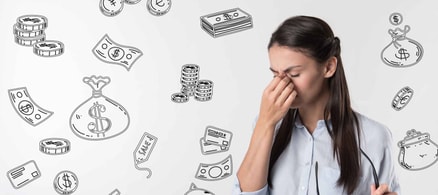1. Review your current financial situation
The first step to debt management can be one of the most difficult: getting a true picture of your financial situation. It can be stressful and scary – but also illuminating.
To start, create a spreadsheet with a row for each creditor that you hold any debt with. The list should include credit cards, student loans, car loans, mortgages and any other sources of debt.
Next, you’ll add four columns:
- Balance owed
- Interest rate
- Monthly minimum payment
- Whether the debt is secured or unsecured.
A secured debt is debt that’s backed by collateral, such as your house or car.
| Creditor | Balance | Interest rate (APR) | Monthly minimum payment | Secured/unsecured |
|---|---|---|---|---|
| Credit Card | $2,500 | 21% | $20 | Unsecured |
| Mortgage | $208,500 | 5.5% | $1,900 | Secured |
| Student Loan | $18,050 | 8% | $375 | Unsecured |
| Car loan | $9,800 | 6.2% | $204 | Secured |
| Department Store Credit Card | $153 | 23% | $10 | Unsecured |
| Mom & Dad | $3,000 | 0% | $0 | Unsecured |
If you haven’t done so in a while or have never, now is also a good time to check your credit report and credit score. Your credit report will also give you a list of all creditors and balances known to the three major credit bureaus.
Kiss Your Credit Card Debt Goodbye
Having a single loan to pay off makes it easier to manage your payments, and you can often get a better interest rate than what you might be paying on credit cards and car loans.
Fiona is an online marketplace offering personalized loan options based on your unique financial situation.
When you consolidate your debt with a personal loan, you can roll your payments into one monthly installment. Find a lower interest rate and pay down your debt faster today.
Get Started2. Simplify your debts
Kick off your debt-free journey by consolidating your unsecured debts. Debt consolidation doesn't reduce the overall amount you owe, rather it combines many of those bills into one single debt – and you might even get a lower interest rate.
What's more, consolidating your debt can improve your credit score.
3 options for debt consolidation
- Apply for a personal loan
- Apply for a balance transfer credit card
- Apply for a home equity line of credit
Personal loan – Personal loans are offered by banks, credit unions and online lenders. The loans are unsecured, and you pay them back in installments over a period of two to seven years.
Note that you might not get a lower interest rate with a personal loan. In fact, it might be higher than your credit card's APR. Personal loans come with fixed rates, and the payments are due monthly. Read the terms carefully and be sure you can afford the payments before signing for the loan.
Balance transfer credit card – Moving your debt to a balance transfer credit card with a 0% APR is a good way to stop piling up more interest and focus on paying down your debt.
But keep in mind that you may be charged a fee of up to 5% of the amount you transfer.
Look for a credit card with no balance transfer fee. If you have to settle for a card that has a fee, make sure it doesn't cost you more than the interest you'll be saving. Otherwise, the card isn't worth it.
Home equity line of credit – If you're a homeowner and have built up some equity in your house, you can consolidate your debt by taking out a home equity line of credit, or HELOC.
It's a revolving credit line similar to a credit card: You can use it, pay it off and use it again. Specifically, you'll be using it to pay off other debts.
One benefit of a HELOC is the fairly low interest rate. Compared to the average credit card APR of about 17%, HELOC rates are averaging around 7%. And, you can get a home equity line even if you have bad credit.
A major disadvantage of a HELOC is that it's secured using your home as collateral. This means if you don't make your payments, you could lose your house.
3. Determine the best way to pay off your debt
Once you've pulled your debt together into a more manageable pile, it's time to decide how to make it go away. Two primary approaches are the avalanche method and the snowball method.
Avalanche method
In the avalanche method, you attack your largest debt first. Since your biggest debt may be costing you the most in interest or have the highest interest rate attached to it, it makes sense to get it off your plate the fastest.
You might want to automate your debt payments, to keep yourself on track toward wiping out what you owe. Set regular monthly payments from your bank account, but be sure you can afford them so that you avoid overdrawing your account and triggering overdraft fees.
Once the largest debt is paid off, you can focus on the second-largest debt, and so on. Crushing your big debts first can save you a mountain of money in interest charges.
Debt snowball method
Although the avalanche method is the more rational way to pay off debt, people aren’t always that rational. That’s where the debt snowball method comes in.
A team of Kellogg School researchers found that people with large credit card balances were more likely to pay down their entire debt if they focused first on paying off the smaller balances.
Winning little victories against the small debts helps encourage people to keep paying down what they owe. By the time they're left with their biggest debt, they'll be confident debt-crushing pros.
Going this route may cost more in interest, but no matter which method you choose, staying motivated to make regular payments is the key to becoming debt-free.
Stop overpaying for home insurance
Home insurance is an essential expense – one that can often be pricey. You can lower your monthly recurring expenses by finding a more economical alternative for home insurance.
SmartFinancial can help you do just that. SmartFinancial’s online marketplace of vetted home insurance providers allows you to quickly shop around for rates from the country’s top insurance companies, and ensure you’re paying the lowest price possible for your home insurance.
Explore better rates4. Boost your income

Increasing your monthly income will allow you to put more money towards repaying your debt.
Consolidation, automation and determination can only go so far. If you're really serious about dumping your debt, you'll need to make more money.
Simply put: Increasing your monthly income will allow you to put more money toward paying off your balances.
Look for a side gig – With so many side gigs available today, there's definitely one that suits your needs and lifestyle.
Uber and Lyft, for example, allow you to set your own schedule and earn extra cash in your free time by driving others where they need to go. Each has its own advantages, and you can work for both if you want.
Sell your stuff – Selling things you're not using can free up space in your home or garage while earning cash you can use to pay down your debt. Take an inventory of your clutter and see what you can sell.
Rent your space – If you’re a homeowner, consider being a host on Airbnb. You get to choose when and how often you host. You can share a spare room in your apartment or offer up your entire home the next time you’re out of town.
5. Last resorts to get out of debt
If none of the choices above will work for your situation, there are two final options to consider: debt settlement and bankruptcy. Neither should be approached lightly.
Debt settlement
In a debt settlement, a creditor agrees to accept a negotiated lump-sum payment instead of the entire debt.
A debt settlement will probably damage your credit score and cost you time and money negotiating with your creditors, likely through an intermediary like a debt settlement company.
The company will charge you a fee, often a hefty percentage of the settlement amount, and you may owe income tax on the amount of debt the creditor agrees to forgive.
Bankruptcy
Bankruptcy is a legal process that will allow you to eliminate or repay debts under the protection of a bankruptcy court. You can file for Chapter 7 or Chapter 13 bankruptcy.
Chapter 7 bankruptcy permanently clears away some or all of your debt, but you may have to sell your property and hand over any cash you have. Chapter 13 allows you to keep your property, but you'll have to repay part of your debt over a period of three to five years.
Warning: Bankruptcy will destroy your credit score, and the black mark will linger on your credit report for 10 years.
Sponsored
Follow These Steps if you Want to Retire Early
Secure your financial future with a tailored plan to maximize investments, navigate taxes, and retire comfortably.
Zoe Financial is an online platform that can match you with a network of vetted fiduciary advisors who are evaluated based on their credentials, education, experience, and pricing. The best part? - there is no fee to find an advisor.







